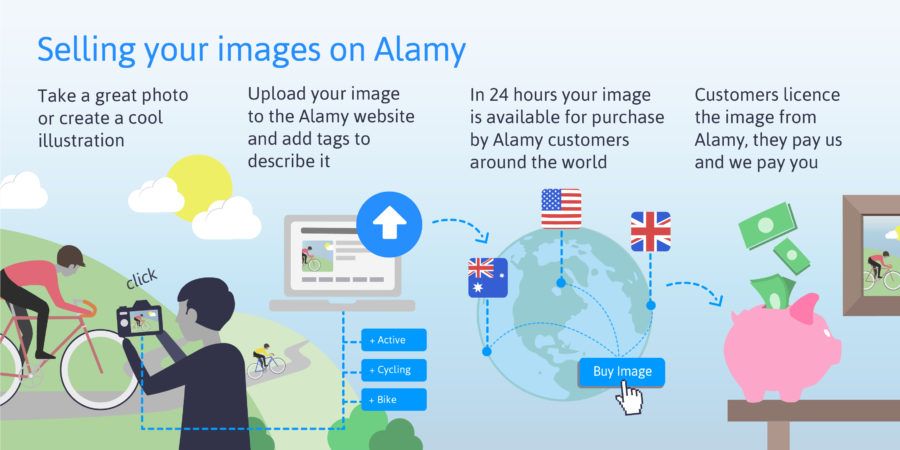1. Introduction:
Alamy is a popular and reputable platform for selling stock photography, attracting a wide range of customers seeking captivating and marketable images. As a photographer, understanding what types of images are in demand and how to capture them is crucial for success on Alamy.
In this blog post, we will explore valuable tips and strategies to help you capture marketable images that have a higher chance of selling on the platform. From understanding Alamy's market and audience to researching existing images, we'll delve into techniques for composition, lighting, post-processing, and keyword optimization. By following these tips, you can enhance your photography skills and increase your chances of success on Alamy.
Also Read This: List of Top Linkedin Companies of UK in 2023
2. What Should I Shoot for Alamy? Tips for Capturing Marketable Images

Tips on what to shoot for Alamy and how to capture marketable images:
- Shoot high-quality images. This means using a good camera and lens, and shooting in RAW format. You should also edit your images to ensure that they are properly exposed, have good composition, and are free of noise.
- Shoot timely images. People are always looking for images that are relevant to current events. If you can shoot images that capture the zeitgeist, you'll be more likely to sell them.
- Shoot unique images. There are millions of images on Alamy, so you need to find a way to make yours stand out. This could mean shooting from a unique perspective, using interesting subjects, or capturing unusual moments.
- Shoot high-demand images. Some types of images are more popular than others on Alamy. For example, images of people, nature, and cities are always in demand.
- Shoot in high resolution. Alamy requires images to be at least 2,500 pixels wide. This ensures that your images will look good when they are displayed on a variety of devices.
- Shoot vertical images. More and more people are using their phones to browse the internet, which means that vertical images are becoming more popular.
- Shoot horizontal images. Horizontal images are still the most common type of image, so you should make sure to shoot some of them as well.
- Caption your images carefully. Your captions should be accurate and informative. They should also include keywords that people are likely to search for.
- Categorize your images. Alamy uses a hierarchical categorization system to organize its images. This makes it easier for people to find your images.
- Promote your images. Once you've uploaded your images to Alamy, you need to promote them so that people can find them. You can do this by sharing them on social media, submitting them to websites that accept stock photos, and contacting potential clients directly.
By following these tips, you can increase your chances of capturing marketable images that sell on Alamy.
The following video is about Alamy:
Also Read This: How to Sell a Photo to Shutterstock: A Step-by-Step Guide
3. Researching Alamy's Image Collection
Researching Alamy's image collection is an important step in understanding the platform's content and identifying opportunities for your own photography. Here are some tips for conducting effective research:
1. Explore Categories and Popular Searches: Browse through Alamy's categories and pay attention to the most popular searches. This will give you insights into the types of images that are in demand and frequently sought after by customers.
2. Analyze Top-Selling Images: Take a closer look at the top-selling images on Alamy. Study their composition, subject matter, lighting, and overall aesthetic. This analysis will help you understand the characteristics that make images successful on the platform.
3. Identify Gaps and Niche Opportunities: While exploring Alamy's image collection, look for areas that are underrepresented or have limited options. These gaps present opportunities for you to capture unique and in-demand images that cater to specific niches.
4. Pay Attention to Image Quality: Take note of the technical quality of the images on Alamy. Consider factors such as sharpness, color accuracy, and noise levels. Aim to match or exceed the quality standards set by successful images on the platform.
5. Note Keyword Usage: Pay attention to the keywords used in successful images. This will give you an idea of the types of descriptive terms and phrases that customers search for. Use this information to optimize your own image metadata and improve discoverability.
By thoroughly researching Alamy's image collection, you can gain valuable insights into customer preferences, identify gaps in content, and tailor your photography to meet market demands. This research will ultimately help you capture images that have a higher potential for success on the platform.
If you are a photographer, you can make money selling your photos online; Instead of the photos staying on your device useless. One of the most popular sites where you can sell photos is: Alamy https://t.co/bXVz4Sar5C Shutterstock https://t.co/E4lqzZrPxp pic.twitter.com/QtQGWbXRtZ
— YOUCEF NB (@AtLwmat) April 20, 2022
Also Read This: Try This Easiest Tool to Download Kashmir Files from Telegram
4. Post-Production and Editing Tips
Post-production and editing play a crucial role in enhancing the visual appeal and marketability of your Alamy images. Here are some tips to help you make the most out of your post-processing:
1. Maintain Naturalness: While editing your images, aim to maintain a natural and realistic look. Avoid excessive manipulation that can make the image appear artificial or overly processed. Strive for a balanced and authentic result.
2. Adjust Exposure and Contrast: Fine-tune the exposure and contrast of your images to ensure a pleasing balance of light and dark areas. This helps create visual impact and draw attention to key elements within the frame.
3. Color Correction and White Balance: Correct any color casts or discrepancies in your images to ensure accurate and appealing colors. Adjust the white balance to match the scene's lighting conditions, resulting in a more realistic representation.
4. Sharpening and Noise Reduction: Apply appropriate sharpening techniques to enhance details and make your images appear crisp. Additionally, use noise reduction tools to minimize any unwanted digital noise, particularly in low-light or high ISO situations.
5. Crop and Composition: Consider cropping your images to improve composition and remove any distracting elements. Pay attention to the rule of thirds, leading lines, and other composition guidelines to create visually pleasing and balanced images.
6. Retouching and Spot Removal: Remove any distracting elements or blemishes from your images using retouching tools. This could include dust spots, sensor spots, or other imperfections that might detract from the overall quality.
7. Metadata and Keywords: During the post-production process, don't forget to add relevant metadata and keywords to your images. This helps improve discoverability and ensures that your images are accurately represented in search results.
Remember, the goal of post-processing is to enhance your images while maintaining their authenticity and natural appeal. Experiment with different editing techniques, but always ensure that your final result enhances the visual impact and marketability of your Alamy images.
Also Read This: Getty Images Contributor Earnings: Understanding How Much You Can Make
5. Test and Experiment
Test and experimentation are vital components of the post-production process. Here's how you can utilize them to improve your Alamy images:
1. Try Different Approaches: Don't be afraid to experiment with various editing techniques and styles. Explore different color grading options, contrast adjustments, and creative effects to see what works best for each image.
2. Use Presets and Filters: Experiment with preset editing tools or filters to quickly apply different looks to your images. This can help you explore different aesthetics and find the ones that enhance your images effectively.
3. Compare Before and After: Before finalizing your edits, compare the edited version with the original image. This allows you to evaluate the impact of your adjustments and ensure that you're enhancing the image without going overboard.
4. Seek Feedback: Share your edited images with peers, photographers, or online communities for constructive feedback. This outside perspective can provide valuable insights and help you refine your editing skills.
5. Monitor Customer Responses: Keep an eye on the response your images receive from customers on Alamy. Pay attention to which images sell well and receive positive feedback. This information can guide you in understanding the preferences of the Alamy market and adjusting your editing choices accordingly.
6. Learn from Others: Study the work of successful photographers on Alamy and analyze their editing techniques. Understand how they use post-processing to enhance their images and adapt those insights to your own work.
7. Maintain Consistency: While experimenting, aim for consistency in your editing style across your portfolio. Consistent editing helps create a cohesive body of work and establishes your unique visual identity.
By testing and experimenting with different post-processing techniques, you can continually refine your skills and discover new ways to enhance the visual appeal of your Alamy images. This iterative process allows you to develop your own unique editing style while staying adaptable to the evolving demands of the market.
Also Read This: Echoes of Harmony: Keeping Spotify Playing While Using Other Apps on iPhone
6. Understanding Alamy's Market and Audience
To capture marketable images for Alamy, it is essential to have a clear understanding of the platform's market and target audience. By knowing what types of images are in demand and appealing to Alamy's customer base, you can tailor your photography to meet their specific needs. Here are some key aspects to consider:
1. Image Categories: Explore the various categories and themes that perform well on Alamy. This includes popular subjects such as lifestyle, travel, nature, business, and technology.
2. Commercial Appeal: Alamy caters to a diverse range of customers, including businesses, publishers, designers, and advertisers. Consider the types of images that would be useful for these clients, such as high-quality product shots, authentic lifestyle scenes, and conceptual images.
3. Market Trends: Stay updated with current trends and topics that are relevant to Alamy's audience. This could involve capturing images related to sustainability, diversity and inclusion, remote work, or emerging technologies.
4. Research Competitors: Analyze the images that are already successful on Alamy. Look for gaps or areas where you can offer unique perspectives or explore subjects that haven't been extensively covered.
By understanding Alamy's market and audience, you can align your photography style and subjects with what customers are seeking, increasing your chances of capturing marketable images that resonate with potential buyers.
Also Read This: How to Sell Illustrations on Depositphotos: A Step-by-Step Guide
7. FAQ:
Q1. What should I shoot for Alamy?
ANS: Here are some tips on what to shoot for Alamy:
- Shoot high-quality images. This means using a good camera and lens, and shooting in RAW format. You should also edit your images to ensure that they are properly exposed, have good composition, and are free of noise.
- Shoot timely images. People are always looking for images that are relevant to current events. If you can shoot images that capture the zeitgeist, you'll be more likely to sell them.
- Shoot unique images. There are millions of images on Alamy, so you need to find a way to make yours stand out. This could mean shooting from a unique perspective, using interesting subjects, or capturing unusual moments.
- Shoot high-demand images. Some types of images are more popular than others on Alamy. For example, images of people, nature, and cities are always in demand.
- Shoot in high resolution. Alamy requires images to be at least 2,500 pixels wide. This ensures that your images will look good when they are displayed on a variety of devices.
- Shoot vertical images. More and more people are using their phones to browse the internet, which means that vertical images are becoming more popular.
- Shoot horizontal images. Horizontal images are still the most common type of image, so you should make sure to shoot some of them as well.
Q2. How can I capture marketable images?
ANS: Here are some tips on how to capture marketable images:
- Plan your shots. Before you start shooting, take some time to think about what kind of images you want to create. What are you trying to capture? Who is your target audience? Once you have a plan, you'll be more likely to take high-quality, marketable images.
- Use the right equipment. A good camera and lens are essential for capturing high-quality images. You should also invest in a tripod to keep your camera steady and a memory card with plenty of storage space.
- Shoot in RAW format. RAW format gives you more control over the final image in post-processing.
- Edit your images. Once you've taken your photos, take some time to edit them. This will help you to improve the exposure, contrast, and color of your images.
- Caption your images carefully. Your captions should be accurate and informative. They should also include keywords that people are likely to search for.
- Categorize your images. Alamy uses a hierarchical categorization system to organize its images. This makes it easier for people to find your images.
- Promote your images. Once you've uploaded your images to Alamy, you need to promote them so that people can find them. You can do this by sharing them on social media, submitting them to websites that accept stock photos, and contacting potential clients directly.
8. Conclusion:
In conclusion, post-production and editing are crucial steps in maximizing the impact of your Alamy images. By implementing the tips and techniques discussed, you can elevate the quality, marketability, and discoverability of your photos. Remember to maintain a consistent style while adapting your editing approach to suit each image's unique characteristics.
Experimentation and testing are key to refining your skills and finding what works best for your portfolio. Strive for authenticity, balance, and visual appeal in your edits, while keeping in mind the preferences and trends of the Alamy marketplace. With dedication and continuous improvement, you can create captivating images that stand out and attract buyers on Alamy.














